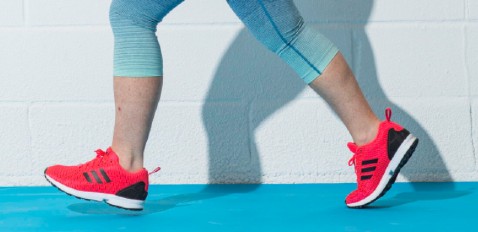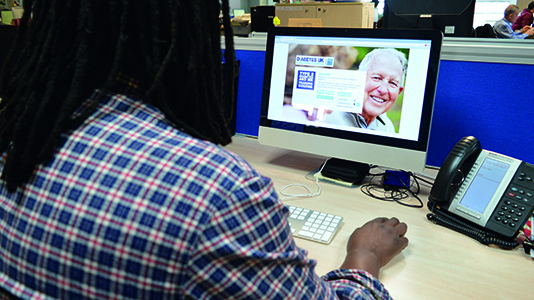If you live with diabetes, you’re much more likely to develop problems with your feet. These problems can be serious and can cause ulcers or infections and for some people these problems could lead to amputations.
But most problems, including amputations, can be prevented. If you take care of your feet and check them regularly, you can reduce your risk of developing foot problems.
How to check your feet
For simple steps to healthy feet and how to check them, watch our video.
{"preview_thumbnail":"/resources-s3/public/styles/video_embed_wysiwyg_preview/public/video_thumbnails/jC9hXPURsQA.jpg?itok=RKplxqBV","video_url":"https://youtu.be/jC9hXPURsQA","settings":{"responsive":1,"width":"854","height":"480","autoplay":0},"settings_summary":["Embedded Video (Responsive)."]}
Diabetes and footcare
If you’ve lost feeling in your feet, it may be harder to look after them. Speak to your healthcare team as you may need help from a podiatrist or foot protection service. You can learn more here about the relationship between diabetes and foot problems, and read our tips below for looking after your feet.
You can also order or download our free guide to looking after your feet from our shop:
Diabetes and Looking After Your Feet is available to download in 9 different languages or you can order a printed version in English, Polish or Romanian.
10 simple steps to prevent foot problems
If you want a few pointers on looking after your feet, then take our simple steps to healthy feet:
- Get help to quit smoking
- Manage your blood sugars, cholesterol and blood pressure
- Check your feet every day
- Eat a healthy, balanced diet and stay active
- Cut your nails carefully
- Make sure your footwear fits
- Use moisturising cream every day
- Don’t use blades or corn plasters
- Get expert advice
- Keep useful numbers handy
1. If you smoke, stop
Smoking makes it harder for blood to circulate and move around your body, including to your feet. This puts you at even more of a risk of amputation.
If you think you might need help to stop smoking, take the first step and ask your healthcare team for support.
2. Manage your blood sugar levels, cholesterol and blood pressure
Keeping your blood sugar levels as close to your target range as possible can be difficult but can help prevent damage to your feet or stop the damage from getting worse. We've got lots of information to help you manage your blood pressure, cholesterol and how to check your blood sugar levels.
You can go on diabetes education courses to help you manage your diabetes. Speak to a healthcare professional about which course is right for you.
You could also speak to a support group or our our helpline. Together, we can help you manage your diabetes.
3. Check your feet every day
Because of diabetes, foot problems can get worse quickly, especially if the feeling in your feet has changed. That’s why it’s important to check them every day.
Look at your feet before you put your socks on in the morning and before you go to bed. If you notice any changes, see a healthcare professional as soon as possible.
If you struggle to lift your feet up, try using a mirror to check the bottom of your feet. Make sure you’re sitting or lying down if you’re using a mirror. Or you could get someone else to check your feet for you. If you live alone, ask a healthcare professional about how to check your feet.
If you’ve lost any feeling in your feet, you need to be especially careful as you won't know if you've hurt yourself. If you’re unsure if you’ve lost any feeling, ask someone to help you do the foot sensitivity test or speak to a healthcare professional.
4. Eat a healthy, balanced diet and keep active
Get support from a dietitian so you know what foods can help you manage your condition and how food affects you. We've got lots of information to help you eat a healthy and balanced diet.
Keeping active will help you manage your diabetes and reduce your risk of serious foot complications. Being active can be difficult, especially if you have problems with your feet or other issues with moving around. Read our information about diabetes and exercise. This has information and tips whatever your ability.
5. Cut your nails carefully
If you have diabetes, cutting your skin by mistake can lead to other problems like ulcers or infections. And you might not even notice you’ve done it.
So, take care when you cut your toenails:
- Cut them often but not too short or down the side.
- Trim them with nail clippers and then use an emery board to file any corners.
- Clean them gently with a nail brush. Don’t use the sharp points of scissors to clean as this isn’t safe.
Washing your feet and toenails everyday will keep them clean and free from infection. Do this with a mix of soap and warm water. Always check the temperature with your wrist or elbow before you put your feet in. Avoid soaking your feet as this just makes the skin more likely to get damaged.
If you’ve lost some feeling in your feet or you’re worried about things like ingrown toenails, see a foot specialist. They’re used to helping with these things.
6. Make sure your footwear fits
Avoid shoes or socks that are too tight, too loose or rub. Shoes that don’t fit well, even those that feel comfortable, can cause problems or make existing conditions worse. As can old inner shoe linings or insoles, or socks with holes or thick seams.
Check your footwear inside and out before putting them on. Make sure nothing sharp like a drawing pin has gone through the sole at the bottom of the shoe. And that nothing has fallen into them.
Choose your footwear carefully.
It’s good to buy shoes that:
- are wide fitting
- have a deep and rounded toe area
- are flat or low heeled
- are fastened by a lace or buckle to stop your feet from sliding around.
Wear new shoes around the house for a short time (20-30 minutes) to check they are comfortable and do not rub.
Shoes that have only been worn inside and for a short time can usually be taken back to the shop if they do not fit well.
If you’re unsure of the fit or style that is best for you, then ask a registered podiatrist for advice. The Royal College of Podiatry has information on choosing suitable footwear.
7. Use moisturising cream every day
Using emollient cream, especially if it has a urea base, will keep your skin healthy. Emollients are moisturising treatments applied directly to the skin to soothe and hydrate it. Talk to your healthcare team about which emollient cream is right for you.
Don’t put cream between your toes, as this can cause problems. The same for talcum powder, if it gets clogged up between your toes, it could make them too dry or cause rubbing between the toes that can affect the skin.
8. Don’t use blades or corn plasters
Avoid plasters, creams and sprays for removing corns or verrucas. They can burn your skin and cause ulcers. Don’t use blades on your corns or tough skin as they could damage it. Pumice stones can help with tough skin but use them with care. If you need help with corns or other skin problems, speak to a podiatrist.
9. Get expert advice
A trained professional should check your bare feet as part of your annual diabetes health check. But if you notice a problem with your foot sooner, ask for an appointment to get it checked as soon as you can rather than wait for your usual check.
Once you’ve had your annual foot check, you should find out your risk of developing a serious foot problem. If you’re at moderate or high risk, your healthcare professional should explain exactly what this means and refer you for monitoring. They’ll also tell you if you need to see a foot specialist.
Ask your foot specialist questions. The more you know, the more you can check any changes in your feet.
10. Know who to call
Keep useful numbers nearby. This could be your GP surgery, your foot specialist and your out-of-hours service.



